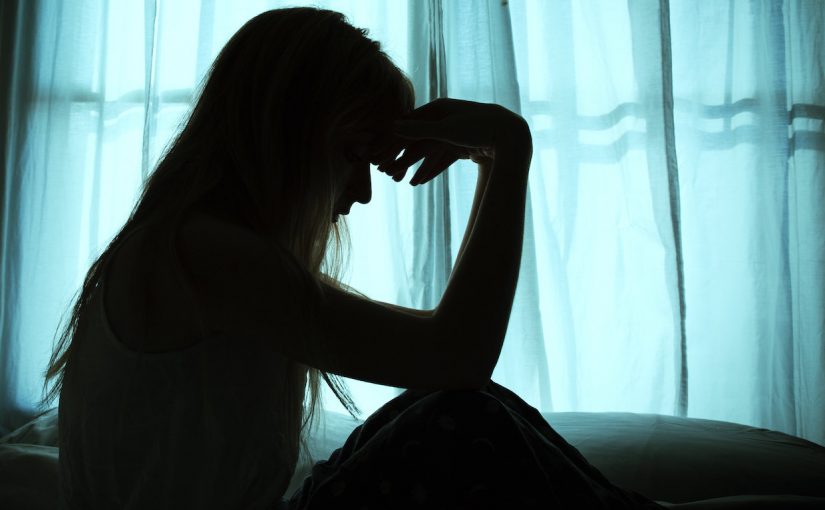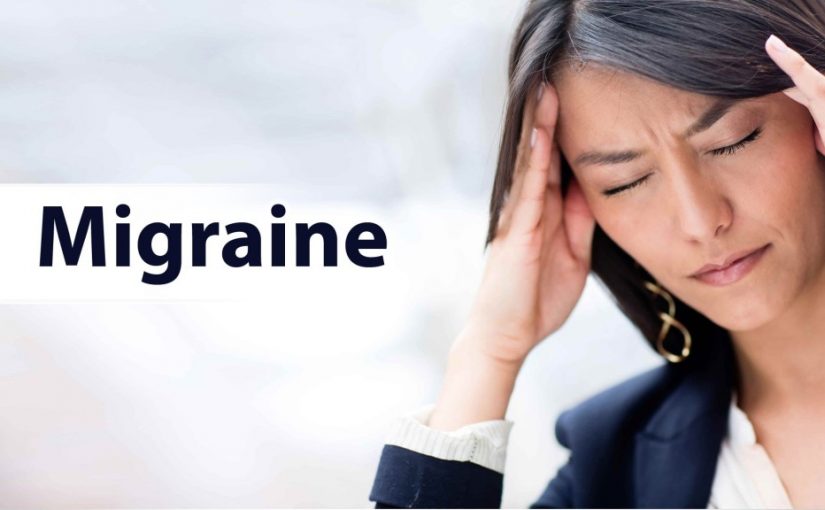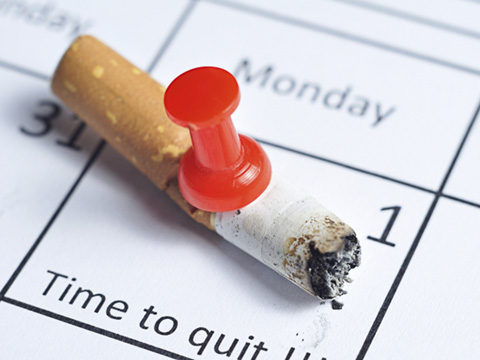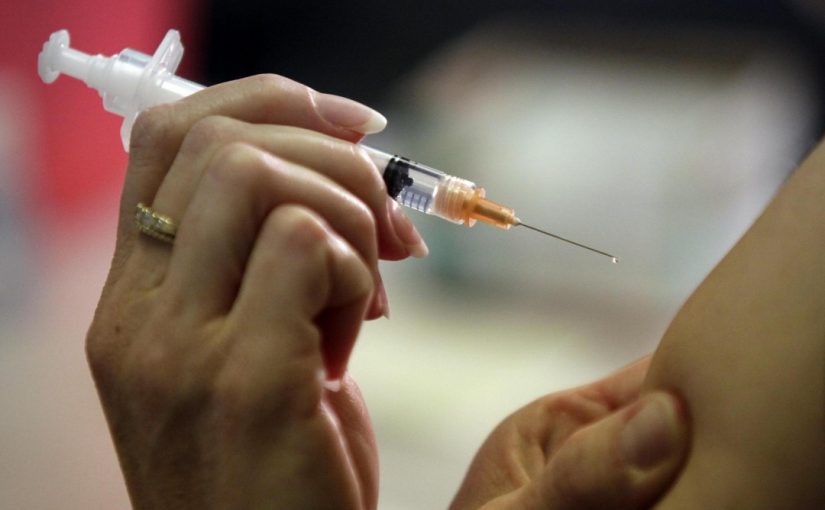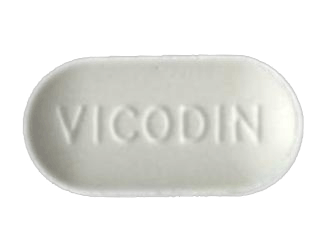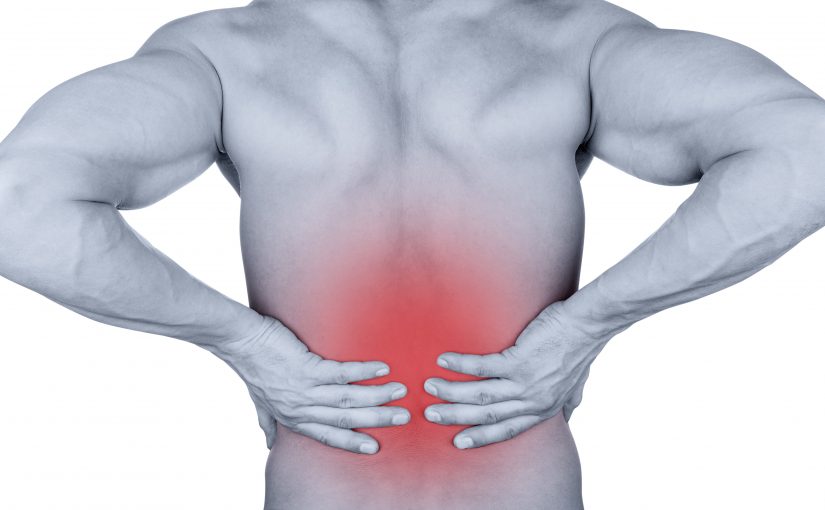Appointment and payment options now available through our website and the Acuity Scheduling phone app. CLICK HERE for appointment availability.
The Medical Benefits of the Rocking Chair: Kinetic Therapy
The rocking chair has been part of Americana since the 18th century. President John F. Kennedy made his Troutman Chair Company rocker famous during his presidency when his doctor, Janet Travell, M.D., recommended it for Kennedy’s chronic back pain from a war injury. In the early to mid 19th century, a rocker inhabited a place of honor in almost every home, an essential item for mothers with newborns and older adults with arthritic knees. It has fallen out of favor in modern homes, but why? This chair is needed now more than ever before.
Health benefits of the rocking chair:
- It soothes both mother and infant as well as increases the bonding process.
- Improves recovery of heart attacks and strokes was reported in an Ottawa Clinical Study.
- It reduces back pain through rhythmic muscle contraction and relaxation.
- The rocking movement reduces arthritic pain in knees by joint movement and lubrication resulting from rocking.
- Reduces swelling and edema in the legs.
- Improves blood circulation and nerve stimuli that are beneficial for peripheral neuropathy resulting from diabetes.
- It improves balance by stimulating proprioception through the feet and movements of the crystals within the inner ear.
- Calms symptoms of attention-deficit/hyperactivity disorder (ADHD) and attention deficit disorder (ADD).
- The University of Rochester School of Nursing showed that rocking chairs improved the psychological well-being of nursing home residents with severely progressed dementia.
- Induces sleepiness in cases of insomnia.
Why not bring back the rocker? Where the typical chair and the dreaded recliner do more to promote premature degeneration of the knees and weakening of the back muscles, the rocker permits us to take a load off and relax yet still ward off some diseases tied to laziness (hypokinetic diseases).
My patients can attest that I do not push products or supplements. That is until now. Make my job easier and your life better—BUY A ROCKING CHAIR.
How to Manage Chronic Pain and Depression when Everything Else isn’t Cutting it.
Pain mitigation is always the goal of treating pain conditions; however, there are cases in which chronic pain can only be managed. Western medicine’s approach to pain management is through medications, i.e., opioids, steroids, anti-inflammatories, muscle relaxers, and last but not least—antidepressants. But what non-pharmaceutical approaches are there to manage pain, and more specifically, to manage the depression associated with chronic pain?
Herbs & Nutritional Supplements
There are many natural supplements used to help with chronic pain and depression, such as turmeric, white willow bark, frankincense, cat’s claw, ginger, St. John’s wort, omega-3 fatty acids, SAM-e, kava kava…and the list goes on. In my over two decades of clinical experience in complementary medicine, I have not found these to be potent enough to handle severe pain or depression. Why? Because either the condition is too advanced or a person’s system is not sensitive enough to respond to the gentle approach of natural supplements.
If a person is accustomed to taking pharmaceutical drugs or potent over-the-counter medications (NSAIDs and Acetaminophen), it is unlikely that a supplement’s milder effect will be able to provide anything close to the same level of relief as a prescription or over-the-counter drug. It is possible to step-down one’s tolerances where natural substances would have a more noticeable effect on the body, but this would require an extended period of abstaining from strong pharmaceuticals as well as refraining from chemicals and stimulants commonly consumed in the diet. For severe chronic pain and depression, abstaining from prescription pharmaceuticals is not a viable (or wise) option for most patients.
Here are a few unorthodox things to consider to manage pain and depression:
Sleeping Beauty probably died young.
Sleeping 6.5-7.5 hours is considered a moderate, and moderation is the key to health. Sleeping too little or too much increases mortality risk. The most significant mortality risk comes with sleeping too long. Cases involving depression often list poor sleep as one of their symptoms, yet what is a more accurate portrayal is fragmented sleep, where they wake not long after the onset of sleep, then a while later they fall asleep again (at any time of day). People with chronic pain and depression, even though they have sleep disturbance at night, generally sleep too much and it poses a risk for increased pain, a worsening of depression, and a higher mortality rate.
Move.
“I hurt, I’m tired, and right now I just need to rest. Tomorrow I’ll go for a walk or go to the gym.” Yep, we tell ourselves that a lot. Tomorrow becomes another yesterday. Movement is different than exercise. With exercise you move at a higher intensity and take days off, with movement you get to sleep and rest—that’s it. Set a routine for movement—go places, piddle around the house and yard, get out the bicycle, or take a stroll with your pet. Here’s the rule: you have to move your legs, and you can’t sit nor lay down. With chronic pain and depression, rest less and move more, especially when you do not want to.
Take off the sunglasses and ditch the sunscreen.
Exposure to sunlight creates a feeling of well-being. Ultraviolet A (UVA) and ultraviolet B (UVB) increases the number of beta-endorphins that make you feel better by reducing pain, increased relaxation, and producing the “runner’s high” during exercise. Sunlight deprivation is connected to depression. Also, insufficient sunlight exposure can result in too much melatonin that causes tiredness, listlessness, and depression. If you are in pain or depressed, stop covering up and shielding out the light—soak it in. But remember, moderation is the key to health. Do not let your skin to get red and avoid sunburns. A wide brim from a hat beats a pair of “looking cool” sunglasses any day and still lets in the full spectrum of light.
Take time to breathe.
Meditation is not a ritual requiring a rigid pretzel posture with incense in the air while repeating a mantra of some foreign language gibberish or flowery positive affirmations. Meditation is about taking a break to breathe. Just check out for a few minutes, sit, and take several mindful breaths. While you are doing this the world around you, and within you, can reset. When meditating, do not try and figure out complex issues or empty your mind of all its many thoughts, just enjoy the breath—in through the nose, down into your belly, up into your lungs, and out your mouth. Meditation is a better alternative to taking a nap and is more rejuvenating. Also, you don’t require a snack after deep breathing like you do a nap, which helps eliminate those unwanted calories.
Choose the right support network.
Do not hang out with depressed people and don’t bring upbeat people down. Support groups may have their place and offer real empathy and compassion, but they can also be a dismal vacuum of commiseration and competition for pity. We all have to paint on a smile now and then, and people with depression have to do it a lot. The upside is that pretending to be happy creates a sense of happiness. A person should not feel fake or their feelings contrived, yet trying to become a better you may require a little “fake it until you make it” attitude. Find a support group of people that support you and not your condition.
Oh, do not forget…
Acupuncture by Troy Sammons works hard to mitigate pain so that you can enjoy the fleeting moments of life without pain and depression. (Obligatory plug. ?)
Coping with Chronic Pain and Depression
Pain mitigation is always the goal of treating pain conditions; however, there are cases in which chronic pain can only be managed. Western medicine’s approach to pain management is through medications, i.e., opioids, steroids, anti-inflammatories, muscle relaxers, and last but not least—antidepressants. But what non-pharmaceutical approaches are there to manage pain, and more specifically, to manage the depression associated with chronic pain?
Herbs & Nutritional Supplements
There are many natural supplements used to help with chronic pain and depression, such as turmeric, white willow bark, frankincense, cat’s claw, ginger, St. John’s wort, omega-3 fatty acids, SAM-e, kava kava…and the list goes on. In my two-decades of clinical experience in complementary medicine, I have not found these to be potent enough to handle severe pain or depression. Why? Because either the condition is too advanced or a person’s system is not sensitive enough to respond to the gentle approach of natural supplements.
If a person is accustomed to taking pharmaceutical drugs or potent over-the-counter medications (NSAIDs and Acetaminophen), it is unlikely that a supplement’s milder effect will be able to provide anything close to the same level of relief as a prescription or over-the-counter drug. It is possible to step-down one’s tolerances where natural substances would have a more noticeable effect on the body, but this would require a long period of abstaining from strong pharmaceuticals as well as refraining from chemicals and stimulants commonly consumed in the diet. For severe chronic pain and depression, abstaining from prescription pharmaceuticals is not a viable (or wise) option for most patients.
Here are a few unorthodox things to consider to manage pain and depression:
Sleeping Beauty probably died young…
Sleeping 6.5-7.5 hours is considered a moderate, and moderation is the key to health. Sleeping too little or too much increases mortality risk. The greatest mortality risk comes with sleeping too long. Cases involving depression often list poor sleep as one of their symptoms, yet what is a more accurate portrayal is fragmented sleep, where they wake not long after the onset of sleep or sleep latency. Fragmented sleep can occur when a person has spent a long time in bed or had a long sleep (at any time of day). People with depression, even though they have sleep disturbance at night, generally sleep too much.
Move
“I hurt, I’m tired, and right now I just need to rest. Tomorrow I’ll go for a walk or go to the gym.” Yep, we tell ourselves that a lot. Tomorrow becomes another yesterday of today. Set a routine for movement, post it visually for all to see, and follow it daily. Movement is different than exercise. With exercise you get days off, with movement you get to sleep and rest—that’s it. Rest less and move more, especially when you do not want to.
Take Off the Sunglasses and Ditch the Sunscreen
Exposure to sunlight creates a feeling of well-being. Ultraviolet A (UVA) and ultraviolet B (UVB) increases the number of beta-endorphins that make you feel better by reducing pain, increased relaxation, and producing the “runner’s high” during exercise. Sunlight deprivation is connected to depression. Also, insufficient sunlight exposure can result in too much melatonin that causes tiredness, listlessness, and depression. So stop covering up and shielding out the light—soak it in. Okay, back to moderation being the key to health, do not let your skin to get red and avoid sunburns. A wide brim from a hat beats a pair of “looking cool” sunglasses any day of the week.
Take time to Breathe
Meditation is not a rigid pretzel posture with incense in the air and repeated mantra of some foreign language gibberish or flowery positive affirmation. Meditation is about taking a break to breathe. Just check out for a few minutes, sit, and take several mindful breaths. While you are doing this the world around you, and within you, can reset. When meditating, do not try and figure out complex issues or empty your mind of all its many thoughts, just enjoy the breath—in through the nose, down into your belly, up into your lungs, and out your mouth. Meditation is a better alternative to taking a nap and is more rejuvenating (although the post-nap snack is pretty hard to compete with).
Choose the Right Support Network
Do not hang out with depressed people and don’t bring Up people down. Support groups may have their place and offer real empathy and compassion, but they can also be a dismal vacuum of commiseration and competition for pity. We all have to paint on a smile now and then, and people with depression have to do it a lot. The upside is that pretending to be happy creates a sense of happiness. A person should not feel fake or their feelings contrived, yet trying to become a better you may require a little “fake it until you make it” attitude.
Oh, do not forget…
Acupuncture by Troy Sammons works hard to mitigate pain so that you can enjoy the fleeting moments of life without pain and depression. (Obligatory plug. ?)
Treating Migraines
The cause of migraines is not completely understood and various theories exist to explain this debilitating condition. A few current theories include vascular disturbances, neuron depression, and local inflammation. The main symptoms classifying migraines are intense head pain with or without visual auras, nausea, dizziness, and light sensitivity.
Epidemiological research by the Center for Disease Control (CDC) reported that nearly 3 million males and 9 million females within the US are chronic sufferers of migraine headaches. Migraines are most common in adolescents and young adults with 30% of migraine sufferers reporting their first attack occurring before age 10. Reports by the CDC indicate a dramatic decrease in migraine occurrences in adults over the age 64. Most sufferers, as much as 70%, report a family history of migraines.
Stress, allergies [1], muscular tightness, pregnancy, menstruation, alcohol ingestion and some diuretics can trigger migraines. However, if someone suddenly begins having migraines without a prior history of headaches, or if headaches intensify with every incident, consult your healthcare provider to rule out any potential life threatening diseases.
Treatment
- Acupuncture can treat the acute pain and also the underlying root cause of the episodes. Acupuncture is often applied along with soft-tissue therapy over the scalp and cervical region to provide rapid relief. Electro-acupuncture is also an effective tool that affects the neuro-muscular zones associated with migraine headaches. Herbal therapy can also be used to prevent the occurrence and severity of future attacks.
- Western treatments include analgesics and/or vasoconstrictors such as Ergotamine, Aspirin, and Ibuprofen. Pharmaceuticals are often prescribed with an antiemetic to improve the absorption of the migraine medication. Pharmaceutical medications are numerous, with new drugs being made available in many forms, including oral, inhalants, injections and suppositories. Consult your physician or pharmacist to determine which medication is most suitable for your condition.
- For a migraine with mild symptoms, aspirin or Ibuprofen may be recommended along with the three S’: Solitude, Silence, and Sleep. Ice packs can be applied to help with the pain and cause vasoconstriction of the blood vessels.
Prevention
Eating foods appropriate for the individual and engaging in regular exercise will promote cellular health and vascular functioning. Avoid tyramine-containing foods such as aged cheese, yogurt, beer, wine, liver and yeast. Observe your eating and activity patterns to identify habits that provoke migraine incidents.
Acupuncture, applied by a licensed practitioner, not only effectively treats the acute symptoms but also addresses the underlying imbalance within the body. Herbal therapies are an important component towards prevention of migraine headaches and are usually given in formulas containing more than 10 different herbs.
Commonly Recommended Suppliments to Prevent Migraines:
- Feverfew, Tanacetum parthenium, shown to reduce the severity, duration and frequency of migraine headaches and lead to improvements in blood vessel tone.
- Magnesium, which influences cerebral vascular tone, inhibition of vasospasm and platelet aggregation.
- Niacin (vitamin B3), which causes vasodilation.
- Ginko, Ginko biloba, is a platelet-aggregating factor (PAF) antagonist.
Self-medication with herbs or supplements is not recommended. Consult a qualified practitioner prior to taking herbal or dietary supplements for appropriate dosage and frequency.
_____________
[1] Most common allergenic foods associated with migraines being wheat, oranges, eggs, coffee and tea, chocolate, milk, beef, corn, white sugar, yeast, mushrooms and peas. Grant ECG. Food allergies and migraine. Lancet 1979; I:966-9.
Time to Stop Smoking
Important tips:
- Support Person: The decision to stop smoking can elicit uncomfortable emotions. Ask someone who is available to you in the next few weeks to act as a sounding board and provide encouragement when needed.
- Affirmation: An affirmation is positive statement repeated often to create desired changes in your life. Repeating the affirmation helps not only to remind you why you are no longer smoking but also imprints a new image of health so that the body can then produce health. Examples: “I am a non-smoker. I make healthy choices in my life for myself and my family.”
- Set boundaries: Establish agreements with other smokers to refrain from smoking in your presence. This includes your spouse. When possible, stay away from smokers until you feel more confident with your nonsmoking health status.
- Drink water: Research shows that dryness causes cravings. Sip water frequently throughout the day.
- Refrain from drinking coffee: Research shows that coffee causes cravings and dehydrates the body.
- Food choices: The best diet during the withdrawal period is a hypoglycemic diet which maintains constant blood sugar levels and avoids food cravings. Meals should consist of fresh fruits, vegetables, proteins, and complex carbohydrates in six meals a day. Try to avoid sweets and baked flour products. Candy upsets the blood sugar level, which can aggravate smoking-withdrawal symptoms. Sugar substitutes, such as NutraSweet, are sweeter than sugar and cause further sugar cravings.
- Managing cravings: Cravings feel like they will last forever but actually fade in two minutes. Plan what you will do during a craving. Examples: Take your herbs; repeat your affirmation; breathe deeply; walk to another place; work on a project or hobby; call your support person. If you’re hungry have something to eat – it’s not a cigarette craving.
- Exercise Regularly: Exercise relieves stress, eliminates boredom, increases circulation, strengthens the respiratory system, and promotes detoxification of tissues. If you do not already have an exercise program, start one today.
- Hang in there! It is only a short time before your body is free from nicotine and the cravings end.
Stop Smoking Checklist
- Throw away all of your cigarettes – don’t just hide them or give them away.
- Change your daily routine. For example, if you usually smoke in the morning while reading the newspaper, try siting in a different place, reading something different or listening to music. This doesn’t mean don’t do the things you enjoy, just do them at different times of the day to develop a new non-smoking routine.
- Openly tell people that you have stopped smoking. This is an important affirmation and outward commitment to yourself and others that you are going to stop smoking. By telling your friends and family outright, they will be sensitive to your situation and openly support your decision. This proactive notice will also circumvent the uncomfortable situation of having to tell a smoker that you are trying to quit after they have already lit-up a cigarette.
- Thoroughly clear away all signs of smoking. Clean your house, car, ashtrays, and all other areas or items that have had contact with tobacco smoke. Schedule an appointment to get your teeth cleaned and a manicure to remove nicotine stains.
- Don’t try and stop all of your “bad habits” at once. If you have multiple harmful habits, start by stopping the least difficult first then move on to another. For example, if you eat a lot of sweets or drink an excessive amount of coffee (both of which can contribute to cigarette cravings), start by eliminating or reducing the one you have the least desire for. Once you have overcome your smaller hurdles you will be more prepared and confident to overcome the more difficult ones.
- If you smoke a cigarette don’t give up or feel guilty. Everyone slips now and then, we are creatures of habit and prone to mistakes. Because you make a mistake and have a cigarette, don’t feel like you lost everything and have to start from scratch. Realize your mistake, correct yourself, and move on. Once you have corrected your mistake, think positively: “Well, at least I only had one cigarette today, normally I would have smoked a pack by now.”
- Don’t tell others to stop smoking, instead focus on yourself. If you try to persuade others to stop smoking when they are not ready, it will only cause people to alienate you. Believe it or not, friends who smoke can be your biggest supporters. Maintaining these friendships can be very important, especially during a time when you need support and encouragement.
- Take time to acknowledge your efforts. Take a moment to congratulate yourself and your accomplishments. This is not being boastful or arrogant; it’s simply self-recognition.
Links between Autoimmune Diseases and Vaccinations
The term “adjuvant” used in this article refers to a substance that enhances the immune system’s response to an antigen. The flu vaccine contains a flu virus antigen to stimulate the body’s production of antibodies, and also adds an adjuvant to amp up the production of these antibodies.
I’m not advocating that people shouldn’t get flu shots. I do encourage patients to be informed about what they are being injected with and make an informed decision as to whether or not to get a supercharged vaccination that could have unwanted side effects.
Opioid-Induced Hyperalgesia (OIH). Opioid medications can worsen your chronic pain.
Opioids reduce the intensity of pain signals reaching the brain and diminish the emotional response to pain. Opioids include: Hydrocodone (Vicodin), Codeine, Fentanyl, Hydromorphone, Meperidine, Morphine, Sufentanil, Oxycodone, Oxymorphone, Buprenorphine, Methadone, and Tramadol.
Opioid-induced hyperalgesia (OIH) is a condition whereby opioid therapy has a reverse effect on patients and causes increased sensitivity to certain types of pain. The symptoms of OIH are often difficult to diagnose and symptoms present as a worsening of the patient’s chronic pain with regions of pain spreading to other areas of the body. This worsening pain condition can be incorrectly interpreted as a patient developing a tolerance to the opioid that reduces the drug’s effect. This may not be the case. Prescribing higher dosages of opioids can paradoxically worsen a patient’s pain condition.
There is no question that getting off opioids can be very difficult and some physicians don’t want to assume the responsibility and risk that can arise from withdrawal and detox. An integrative medical approach is increasingly being sought after by both physician and patient to reduce dependence on opioids and to develop a safer pain management plan.
Acupuncture has been used to treat both chemical addiction and chronic pain. Acupuncture observes the improvement in pain reduction as a reduction in the frequency, intensity, and location of pain. Ideally, progress in the treatment of pain with acupuncture should result in the complete opposite effect of OIH—a reducing and localizing of pain, a normalizing of pain tolerance, and a restoration of body functions (normal bowl movements, proper digestion and stomach emptying, and sustainable energy with better sleep).
It is important for patients to express their concerns with long-term use of opioids with their physician and to establish an exit strategy to get off pain medications before even starting them.
Aging: Why do I hurt?
As a specialty practitioner in pain mitigation, I frequently get asked why people experience an increasing amount of joint and muscle pain with age. Of course, there are many possible answers for this: arthritis, degenerative spinal disc and joint conditions, neuropathic conditions, dietary inflammatory agents, etc. However, the majority of generalized joint and muscle pain are rooted in hypokinetic disease with disuse atrophy.
The terms “hypokinetic disease” and “disuse atrophy” sound like serious medical conditions, but what they essentially refer to is muscle breakdown due to decreased physical activity. When our activity levels significantly drop off our muscles begin to shrink and eventual breakdown of the actual muscle fibers. This process can result in increased sensitivity of the nerves, inflammation, and joint instability.
Acupuncture, deep tissue massage, electro-stimulation, and non-steroidal injection therapy are effective means for eliminating muscle soreness, treating trigger points and hypersensitive nerves, as well as improving circulation and healthy muscle tension.
The number one self-help fix is of course increasing the level of physical activity and re-engaging the muscles. The old myths of having to put in an hour at the gym 3-4 days per week to maintain physical conditioning have long been dispelled. Research has shown that strength exercises performed only once per week can maintain muscles strength in many muscle groups. Now I’m not advocating only exercising once per week; I’m just attempting to reduce the opportunity for excuse making. So consider that while you are not exercising because you hurt, you may be hurting because you are not exercising.
Cupping on Elite Athletes
Cupping is a good tool for Sports Medicine; however, cupping may not be a good idea for an elite athlete prior to an event.
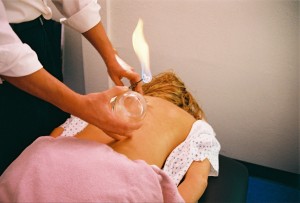
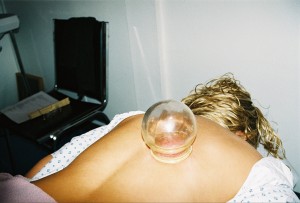
Cupping causes several physiological events to happen. First, the vacuum pressure from the cups pulls in blood and interstitial fluid causing hyperemia (increased blood flow) along with skin stretching and opening of the pores.
Second, the pressure in the small capillary beds for blood within the dermis rupture and hemorrhage to form a hematoma (bruise).
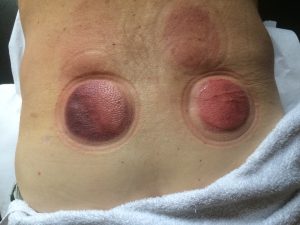
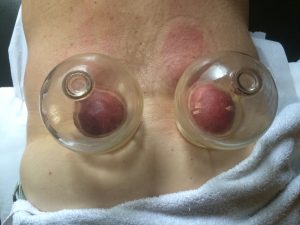 Third, the capillary beds then undergo hemostasis (clotting) to stop the leaking of blood into the interstitial spaces.
Third, the capillary beds then undergo hemostasis (clotting) to stop the leaking of blood into the interstitial spaces.
Forth, an inflammatory response occurs to remove damaged tissue and mobilize 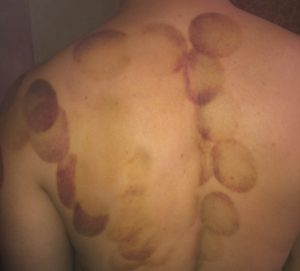 cellular proliferation to the site.
cellular proliferation to the site.
Fifth, tissue repair begins along with angiogenesis (formation of new blood vessels).
Now that you know what cupping does, why would you intentionally break down blood vessels, create inflammation, increase opportunity for fatigue, and compromise the skin’s shielding effect immediately before a world championship competition when winning and losing is measured within a one-thenth of a second?
In my opinion, this specific case of cupping in sports is for a psychological advantage and not a physiological one. If an athlete thinks cupping or Kinesio tape will give them an edge then maybe it will, even if it is just a boost in their confidence.
This confidence may well be nullified by an equal boost in the confidence of competitors by suggesting a weakness or injury.




